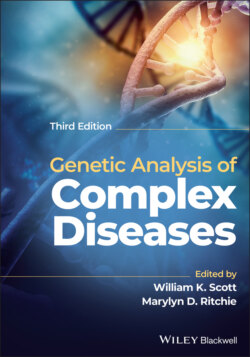Читать книгу Genetic Analysis of Complex Disease - Группа авторов - Страница 73
Family History Approach
ОглавлениеIn this approach, one ascertains the presence or absence of family history in study participants (with and without the condition) and then tests for statistically significant associations between family history and the condition. Khoury et al. (1993) defines three variations on this approach, depending on the level of detail obtained on the relatives. The Abbreviated Family History Approach involves simply questioning the study participants on the presence or absence of the condition in other family members. This method is by far the fastest and cheapest, but also the most susceptible to misclassification because no effort is made to confirm the participant responses. That is, the investigator is relying on the accuracy of the informant’s memory or perception of the family members, rather than directly observing the condition in the relatives. The Detailed Family History Approach requires the investigator to obtain detailed information regarding disease status (including age of onset) and demographic characteristics on each family member. This is the approach routinely utilized in genetic studies. Because the information requested on each family member is more detailed, there is less likelihood of misclassification as with the abbreviated approach. Finally, one can examine and/or interview the relatives directly. This is referred to as the Family Study Approach. Often in this approach, medical records are also reviewed in order to confirm the presence or absence of the condition in the relatives. While time‐consuming and more expensive, this approach certainly provides the most accurate information regarding the family history of a trait.
Once the necessary information has been collected, there are several methods to test for statistically significant association between family history and the condition. If the study design is case‐control, the presence or absence of family history may be treated as a “risk factor” for disease, and the standard epidemiologic 2 × 2 table may be used:
| Family history | ||
|---|---|---|
| Disease in study participant | + | − |
| + | a | b |
| − | c | d |
From here, an odds ratio may be calculated:
(3.1)
The odds ratio derived here is then a measure of the association between family history and the condition. In this case, the odds ratio is the odds of having a positive family history in individuals with the condition compared with the odds of having a positive family history in individuals who are unaffected. This is not to be confused with a risk ratio, which is a prospective measure with respect to an individual’s affection status. That is, the risk ratio is the ratio of the incidence of the condition in individuals with a positive family history compared with those who have a negative family history. However, when the incidence of the condition is low, the odds ratio should closely approximate the risk ratio (Rothman and Greenland 1998).
In keeping with the epidemiologic approach, one can also measure the amount of the disease that can be “attributed” to the presence of a positive family history. This in effect provides information regarding what proportion of the disease is due to genetic causes. There are several methods for calculating attributable fractions, depending on what information is available. Khoury et al. (1993) reviews three of these formulas (Levin 1953; Kelsey et al. 1986; Miettinen 1974) in their book. The Miettinen formula is given below:
(3.2)
